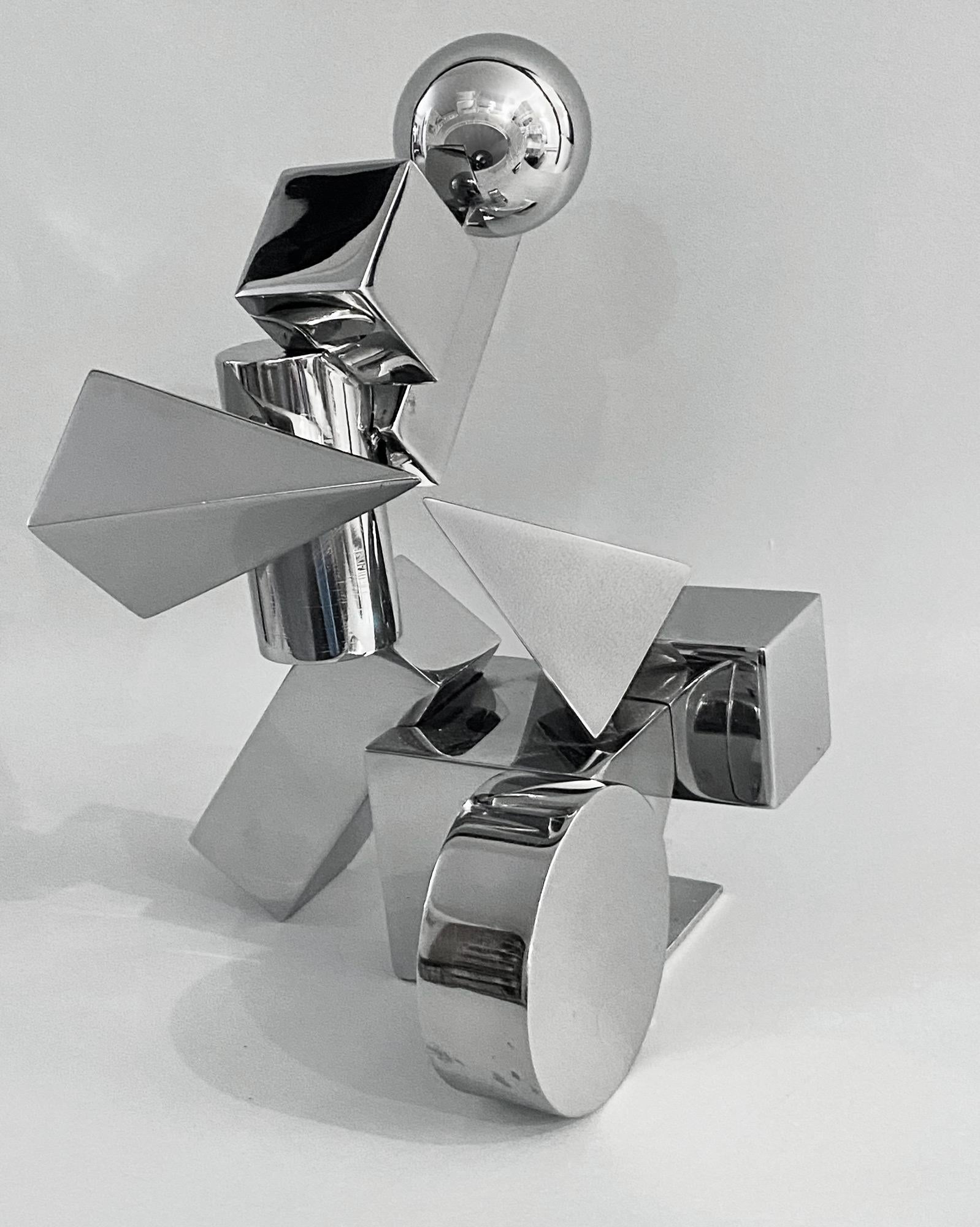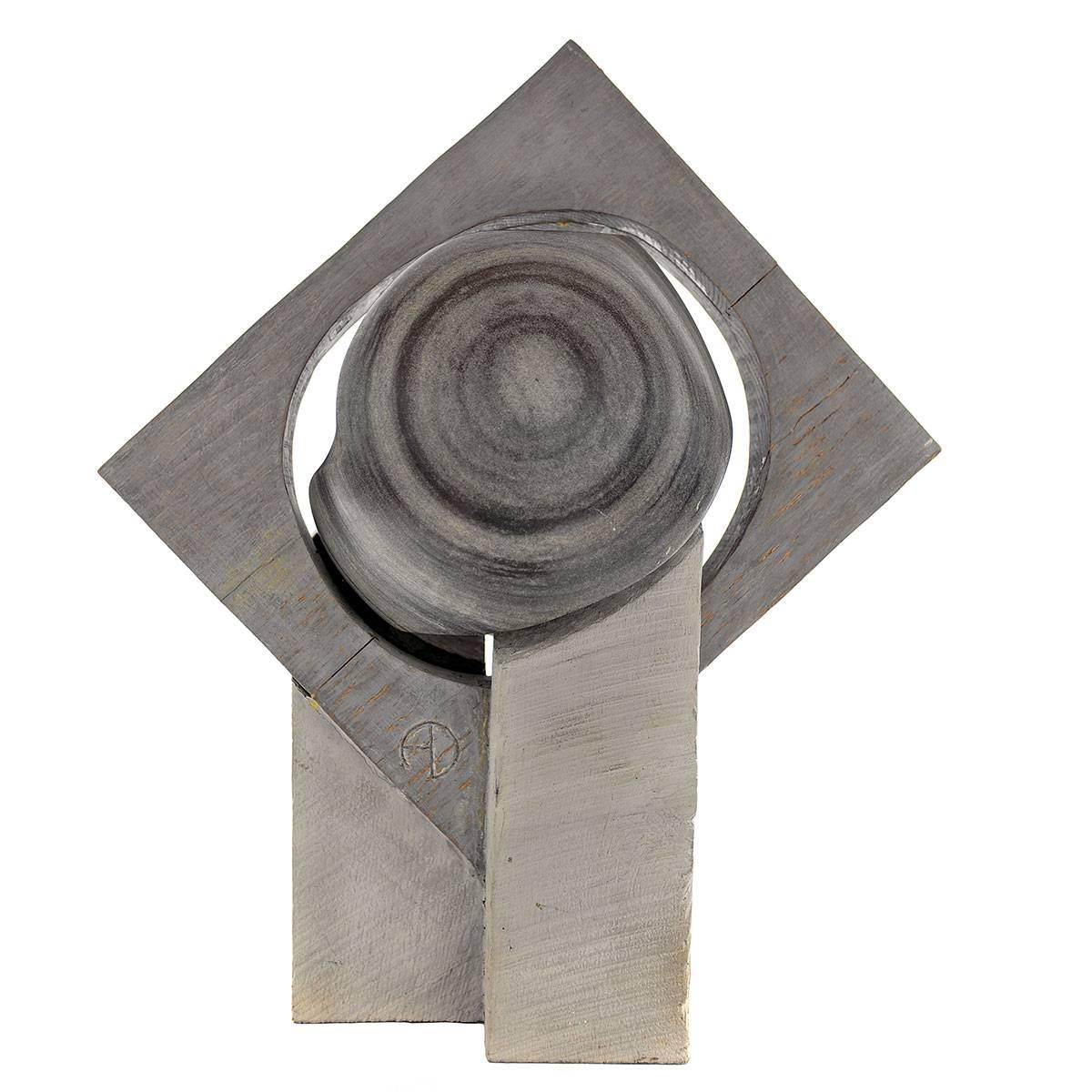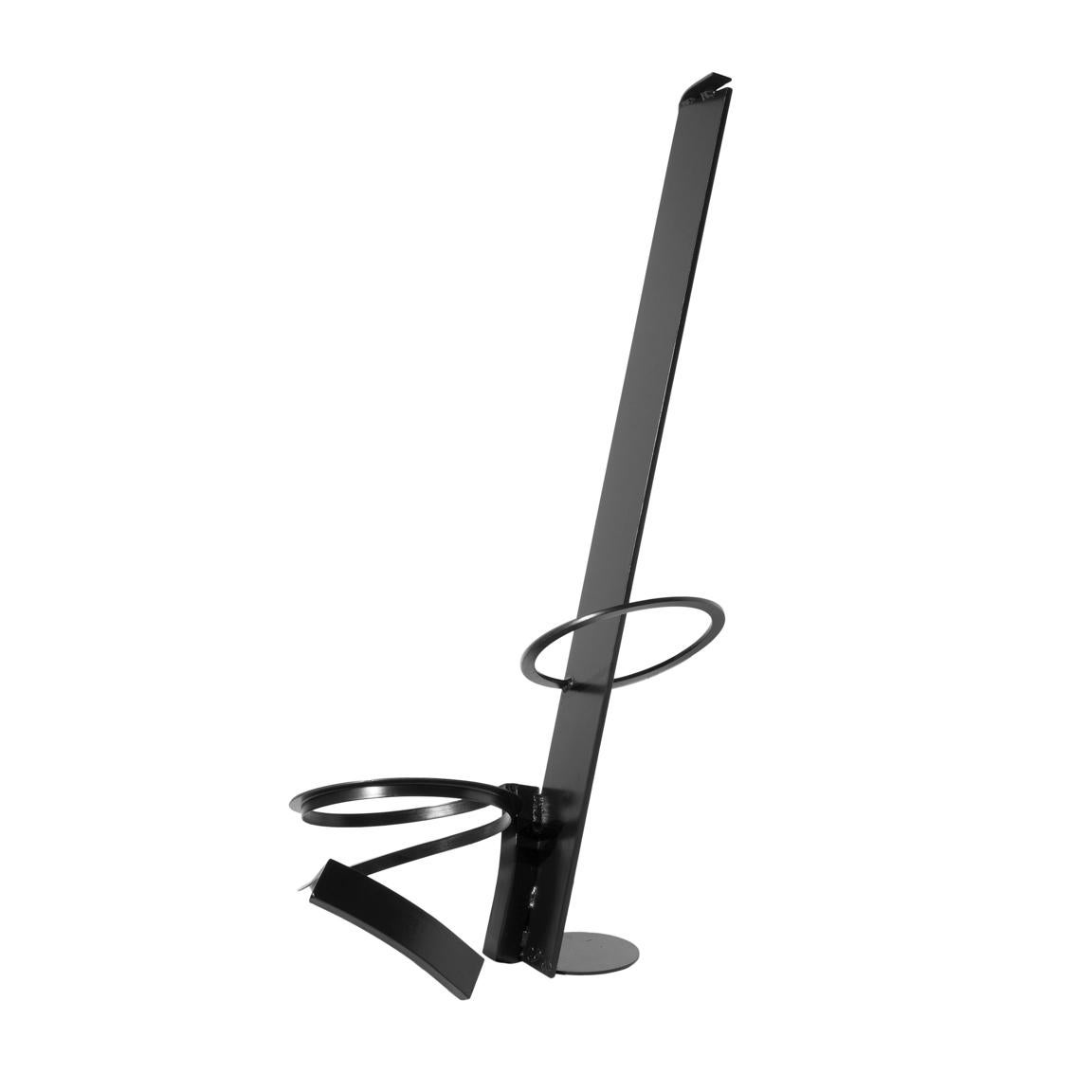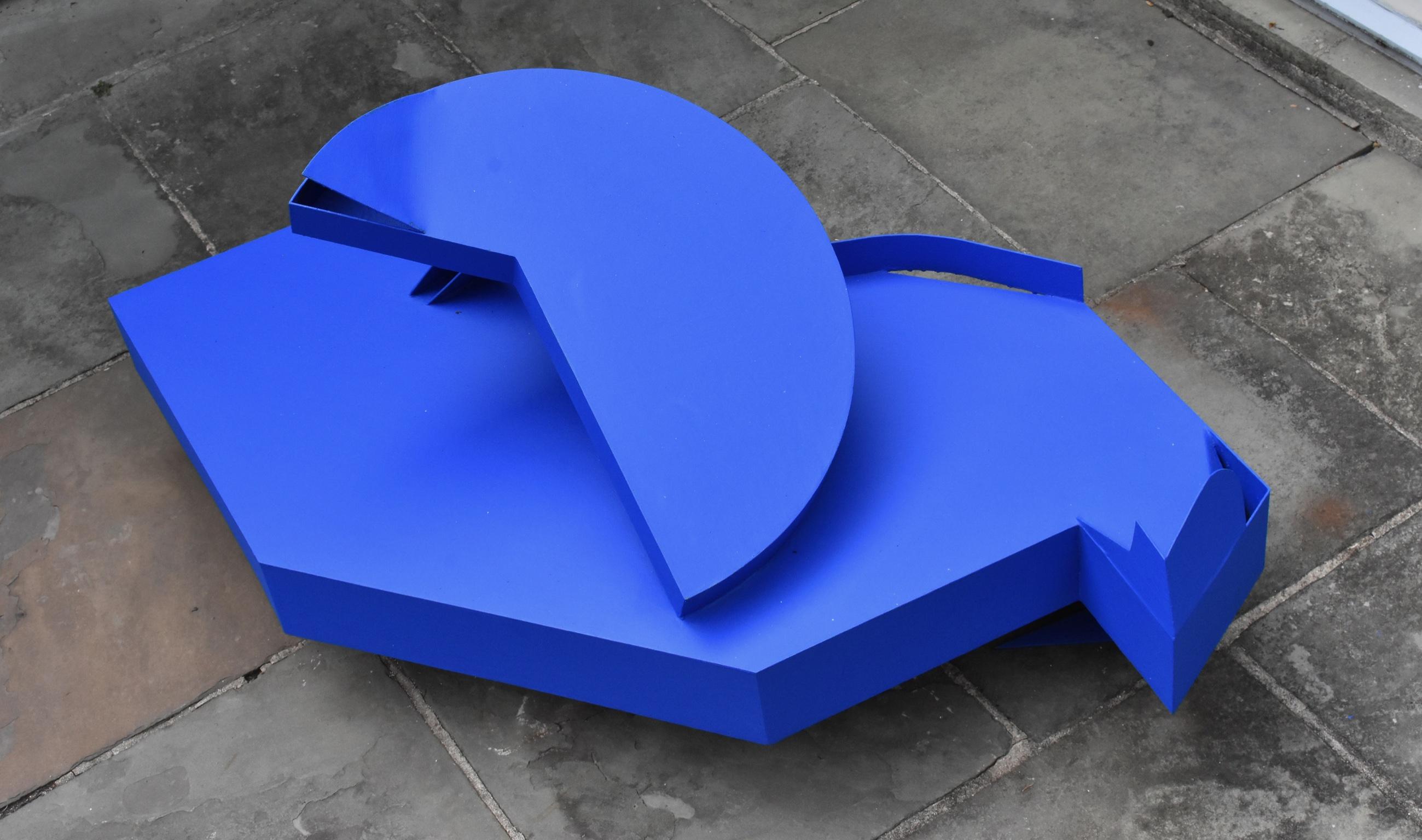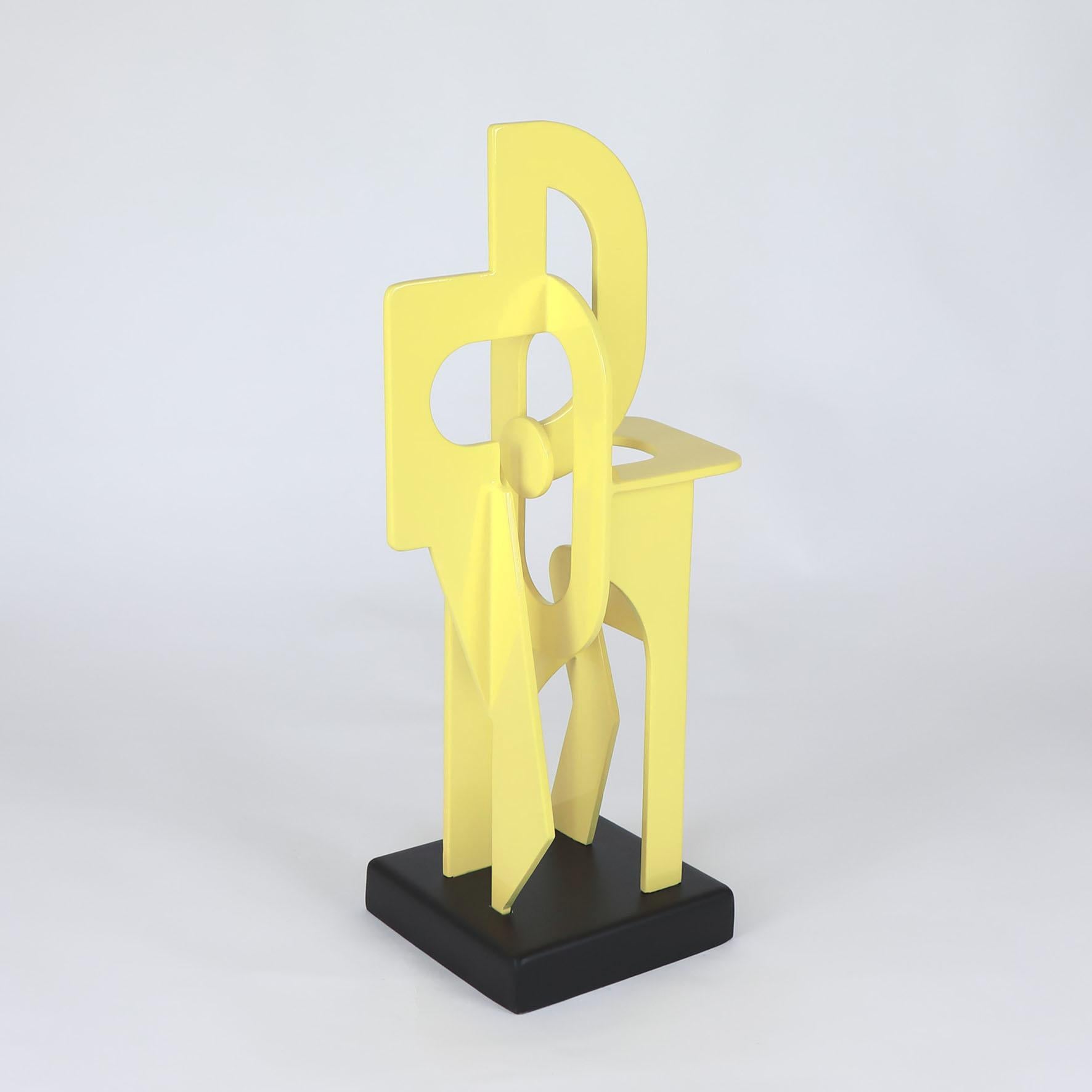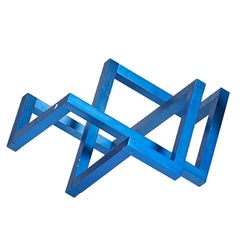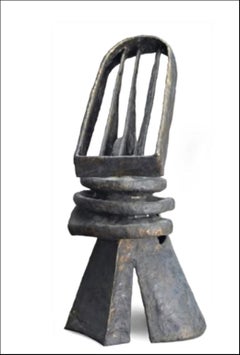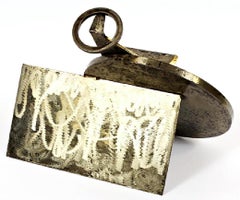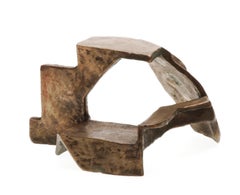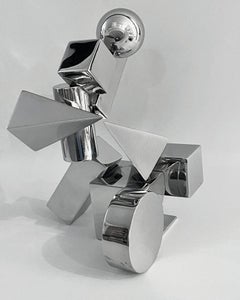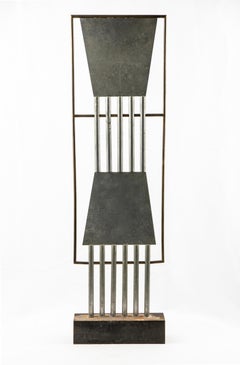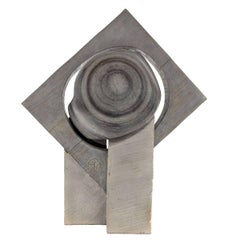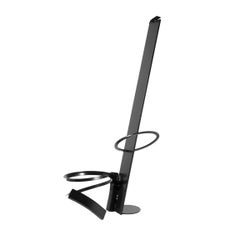Items Similar to Rydbo Maquette, 1989-2000, unique geometric sculpture by renowned British artist
Want more images or videos?
Request additional images or videos from the seller
1 of 4
Nigel HallRydbo Maquette, 1989-2000, unique geometric sculpture by renowned British artist2000
2000
$15,000
£11,393.73
€13,129.43
CA$21,123.72
A$23,418.76
CHF 12,307.47
MX$286,607.23
NOK 153,707.82
SEK 144,270.17
DKK 98,003.08
About the Item
NIGEL HALL
Rydbo Maquette, 1989-2000
Painted Steel
Unique
The authenticity of this work has been confirmed by the artist
Provenance:
Christie's New York: July 25, 2014 (Lot 00059)
Private Collection
The Artist
- Creator:Nigel Hall (1943, British)
- Creation Year:2000
- Dimensions:Height: 7.5 in (19.05 cm)Width: 12 in (30.48 cm)Depth: 9.75 in (24.77 cm)
- Medium:
- Movement & Style:
- Period:
- Condition:very good condition.
- Gallery Location:New York, NY
- Reference Number:1stDibs: LU174529880972
About the Seller
5.0
Platinum Seller
Premium sellers with a 4.7+ rating and 24-hour response times
Established in 2007
1stDibs seller since 2022
450 sales on 1stDibs
Typical response time: 2 hours
- ShippingRetrieving quote...Shipping from: New York, NY
- Return Policy
Authenticity Guarantee
In the unlikely event there’s an issue with an item’s authenticity, contact us within 1 year for a full refund. DetailsMoney-Back Guarantee
If your item is not as described, is damaged in transit, or does not arrive, contact us within 7 days for a full refund. Details24-Hour Cancellation
You have a 24-hour grace period in which to reconsider your purchase, with no questions asked.Vetted Professional Sellers
Our world-class sellers must adhere to strict standards for service and quality, maintaining the integrity of our listings.Price-Match Guarantee
If you find that a seller listed the same item for a lower price elsewhere, we’ll match it.Trusted Global Delivery
Our best-in-class carrier network provides specialized shipping options worldwide, including custom delivery.More From This Seller
View AllGeometric abstraction mid century modern constructivist Signed metal sculpture
Located in New York, NY
Forrest Myers
Untitled geometric abstraction, 1976
Painted aluminum
Signed in the metal with the artist's incised initials (FM) and stamp numbered 52/75; bears Treitel-Gratz foundry ...
Category
1970s Constructivist Abstract Sculptures
Materials
Metal
Maquette for Laureate (unique sculpture)
By Seymour Lipton
Located in New York, NY
Seymour Lipton
Maquette for Laureate, ca. 1968-1969
Nickel silver on monel metal
Unique
18 × 8 1/2 × 7 inches
Marlborough-Gerson Gallery, New York
Acquired from the above by the previous owner, 1969
thence by descent
Christie's New York: Monday, June 30, 2008 [Lot 00199]
Acquired from the above Christie's sale This unique sculpture by important Abstract Expressionist sculptor Seymour Lipton is a maquette of the monumental sculpture "Laureate" - one of Lipton's most iconic and influential works located on the Riverwalk in downtown Milwaukee, Wisconsin. Laureate is a masterpiece that was commissioned by the Allen-Bradley Company in memory of Harry Lynde Bradley and as an enhancement for the newly constructed Performing Arts Center. It is located on the east bank of the Milwaukee River at 929 North Water Street. The Bradley family in Milwaukee were renowned patrons of modernist sculpture, known for their excellent taste who also founded an eponymous sculpture park. For reference only is an image of the monumental "Laureate" one of Milwaukee's most beloved public sculptures. According to the Smithsonian, which owns a different unique variation of this work, "The full-size sculpture Laureate was commissioned by the Marcus Center for the Performing Arts in Milwaukee. In the initial drawings, Seymour Lipton combined details from the architectural plan with a wide variety of images, ranging from musical instruments to a lighthouse on the island of Tobago. He transformed the basic shapes from these sketches into a welded sculpture, which evokes a figure composed of columns, harp strings, and coiled rope. Lipton created this piece to celebrate achievement in the arts. The dramatic silhouette commands your attention, reflecting the title Laureate, which means worthy of honor and distinction. The final version of the piece is over twelve feet high and stands out against the pale, flat buildings of the arts center.,,"
Provenance
Marlborough-Gerson Gallery, New York
Acquired from the above by the previous owner, 1969
thence by descent
Christie's New York: Monday, June 30, 2008 [Lot 00199]
Acquired from the above Christie's sale
About Seymour Lipton:
Born in New York City in 1903, Seymour Lipton (1903-1986) grew up in a Bronx tenement at a time when much of the borough was still farmland. These rural surroundings enabled Lipton to explore the botanical and animal forms that would later become sources for his work. Lipton’s interest in the dialogue between artistic creation and natural phenomena was nurtured by a supportive family and cultivated through numerous visits to New York’s Museum of Natural History as well as its many botanical gardens and its zoos. In the early 1920s, with the encouragement of his family, Lipton studied electrical engineering at Brooklyn Polytechnic Institute and pursued a liberal arts education at City College. Ultimately, like fellow sculptor Herbert Ferber, Lipton became a dentist, receiving his degree from Columbia University in 1927. In the late 1920s, he began to explore sculpture, creating clay portraits of family members and friends.
In addition to providing him with financial security, dentistry gave Lipton a foundation in working with metal, a material he would later use in his artwork. In the early 1930s, though, Lipton’s primary sculptural medium was wood. Lipton led a comfortable life, but he was also aware of the economic and psychological devastation the Depression had caused New York. In response, he generally worked using direct carving techniques—a form of sculpting where the artist “finds” the sculpture within the wood in the process of carving it and without the use of models and maquettes. The immediacy of this practice enabled Lipton to create a rich, emotional and visual language with which to articulate the desperation of the downtrodden and the unwavering strength of the disenfranchised. In 1935, he exhibited one such early sculpture at the John Reed Club Gallery in New York, and three years later, ACA Gallery mounted Lipton’s first solo show, which featured these social-realist-inspired wooden works. In 1940, this largely self-taught artist began teaching sculpture at the New School for Social Research, a position he held until 1965.
In the 1940s, Lipton began to devote an increasing amount of time to his art, deviating from wood and working with brass, lead, and bronze. Choosing these metals for their visual simplicity, which he believed exemplified the universal heroism of the “everyman,” Lipton could also now explore various forms of abstraction. Lipton’s turn towards increasing abstraction in the 1940s allowed him to fully develop his metaphorical style, which in turn gave him a stronger lexicon for representing the horrors of World War II and questioning the ambiguities of human experience. He began his metal work with cast bronze sculptures, but, in 1946, he started welding sheet metal and lead. Lipton preferred welding because, as direct carving did with wood, this approach allowed “a more direct contact with the metal.”[ii] From this, Lipton developed the technique he would use for the remainder of his career: “He cut sheet metal, manipulated it to the desired shapes, then joined, soldered, or welded the pieces together. Next, he brazed a metal coating to the outside to produce a uniform texture.”[iii]
In 1950, Lipton arrived at his mature style of brazing on Monel metal. He also began to draw extensively, exploring the automatism that abstract expressionist painters were boasting at the time. Like contemporaries such as Jackson Pollock, Lipton was strongly influenced by Carl Jung’s work on the unconscious mind and the regenerative forces of nature. He translated these two-dimensional drawings into three-dimensional maquettes that enabled him to revise his ideas before creating the final sculpture.The forms that Lipton produced during this period were often zoomorphic, exemplifying the tension between the souls of nature and the automatism of the machine.
In the years following the 1950s, Lipton’s optimism began to rise, and the size of his work grew in proportion. The oxyacetylene torch—invented during the Second World War—allowed him to rework the surfaces of metal sculptures, thus eliminating some of the risks involved with producing large-scale finished works. In 1958, Lipton was awarded a solo exhibition at the Venice Biennale and was thus internationally recognized as part of a small group of highly regarded avant-garde constructivist sculptors. In 1960, he received a prestigious Guggenheim Award, which was followed by several prominent public commissions, including his heroic Archangel, currently residing in Lincoln Center’s David Geffen Hall.
A number of important solo exhibitions of his work followed at The Phillips Collection in Washington, DC (1964); the Milwaukee Art Center and University of Wisconsin, Milwaukee (1969); the Virginia Museum of Fine Arts in Richmond (1972); the Everson Museum in Syracuse, NY (1973); the Herbert E. Johnson Museum of Art of Cornell University in Ithaca, NY (1973); the National Collection of Fine Arts, Smithsonian Institution (now the Smithsonian American Art Museum) in Washington, DC (1978); and a retrospective in 1979 at The Jewish Museum in New York. In 1982 and 1984 alone, two exhibitions of his sculpture, organized respectively by the Mint Museum (Charlotte, NC) and the Hillwood Art Gallery of Long Island University (Greenvale, NY), traveled extensively across museums and university galleries around the nation. In 2000, the traveling exhibition An American Sculptor: Seymour Lipton was first presented by the Palmer Museum of Art of Pennsylvania State University in University Park. Most recently, in 2009, the Ackland Art Museum in Chapel Hill, NC mounted The Guardian and the Avant-Garde: Seymour Lipton’s Sentinel II in Context.
Since 2004, Michael Rosenfeld Gallery has been the exclusive representative of the Estate of Seymour Lipton and has presented two solo exhibitions of his work—Seymour Lipton: Abstract Expressionist Sculptor (2005) and Seymour Lipton: Metal (2008). In 2013, Michael Rosenfeld Gallery presented Abstract Expressionism, In Context: Seymour Lipton, which included twelve major sculptures by the artist, along with works by Charles Alston, Norman Bluhm, Beauford Delaney, Willem de Kooning, Jay DeFeo, Michael Goldberg, Adolph Gottlieb, Hans Hofmann, Lee Krasner, Norman Lewis, Conrad Marca-Relli, Boris Margo, Alfonso Ossorio, Richard Pousette-Dart, Milton Resnick, Charles Seliger...
Category
1960s Abstract Expressionist Abstract Sculptures
Materials
Metal, Silver
Welded Brushed Steel Sculpture - geometric abstraction (Unique, signed)
By Michael Todd
Located in New York, NY
Michael Todd
Welded Brushed Steel Sculpture - geometric abstraction, 1968
Welded Brushed Steel
Hand signed and dated 1968 in marker on surface....
Category
1960s Abstract Geometric Abstract Sculptures
Materials
Steel
Abstract Bronze Sculpture, Unique Signed work from the estate of Arthur Carr
By Peter Reginato
Located in New York, NY
Peter Reginato
Abstract Bronze Sculpture, ca. 1987
Bronze
Signed on the underside
4 × 6 1/2 × 5 1/2 inches
This bronze sculpture is by the American abstract sculptor Peter Reginato. ...
Category
1980s Abstract Abstract Sculptures
Materials
Bronze
Untitled signed sculpture, from the collection of Dick Polich, Tallix Foundry
By Stephen Talasnik
Located in New York, NY
Stephen Talasnik
Untitled sculpture, from the collection of Dick Polich, Tallix Foundry, ca. 1997
Cast light metal
signed by the artist on the work (see close up photograph)
6 3/5 × 12 × 4 inches
Provenance
Estate of Dick Polich, founder of the legendary Tallix Foundry and Polich Art works Beacon, NY
Manufacturer
Stephen Talasnik at Tallix Foundry, Beacon, New York
This work is signed by the artist (see close up photograh)
Abstract metal sculpture
The work is lightweight so it is believed to be in aluminum or an aluminum alloy,
Provenance: acquired from the Estate of Dick Polich - founder of the legendary Tallix foundry and Polich Art Works.
Polich and Tallix fabricated significant sculptural works over many years, collaborating with such as, Willem de Kooning, Jeff Koons, Roy Lichtenstein, Frank Stella, Helen Frankenthaler, ERTE, Julian Schnabel, Richard Artschwager, Isamu Noguchi, Isaac Witkin...
Category
1990s Abstract Expressionist Abstract Sculptures
Materials
Metal
Study for Sculpture by important Minimalist sculptor geometric abstraction
By Robert Morris
Located in New York, NY
Robert Morris (1931-2018)
Study for Copper Sculpture, 1980
Screenprint with Metallic Ink, signed and numbered in pencil
Pencil signed, dated, and numbered PP1/7 by Robert Morris on t...
Category
1980s Minimalist Abstract Prints
Materials
Ink, Screen
You May Also Like
"Geom-Et-Cetera" abstract sculpture
Located in Glen Ellen, CA
Mirror polished stainless steel.
John Whitehead's first standing geometric abstract sculpture, this piece is a montage of intersecting geometric shapes in 3D space. Various patterns...
Category
Early 2000s Abstract Geometric Abstract Sculptures
Materials
Stainless Steel
Geometric Composition - Sculpture by Giuseppe Pulvirenti - 1984
Located in Roma, IT
Geometric Composition is a sculpture realized in 1984 by Giuseppe Pulvirenti (Siracusa, Sicily, 1959).
Made in Italy.
Steel.
Signed and dated: G. Pulvirenti 84.
The sculpture de...
Category
1980s Modern Figurative Sculptures
Materials
Metal
Abstract Minimalist Geometric Sculpture
By Adolph Dioda
Located in Surfside, FL
Adolph T. DIODA (1915-1991)
Birth place: Aliquippa, PA
Lived in West Aliquippa, PA; Detroit, MI; Phila. & Jenkintown, PA
Profession: Sculptor, educator
Studied: Carnegie Inst Technol; Cleveland School of Art; Barnes Fnd., Art Student League New York, NY; also with John B Flannagan, New York.
Exhibited: WMAA, 1939-40; Carnegie Inst., 1941; AIC, 1940, 1951; Sculpture Int., Philadelphia Mus. of Art, 1940-49; AA Pittsburgh, 1941-45; Carved in Stone, Bucholtz Gallery, New York, 1945; PAFA, 1946-47 & 1968 (prize, 1947); Philadelphia A. All., 1951; Carlen Gal., Philadelphia, 1951; 2-man exh. with William Kienbusch...
Category
1970s Minimalist Abstract Sculptures
Materials
Stone, Marble
John Piet "Untitled" Abstract Geometric Steel
Located in Detroit, MI
SALE ONE WEEK ONLY
John Piet's "Untitled" from 1974 is a welded sculpture with two opposing forms connected by a swoop of steel. Piet's sculptural work explores the tension between contending elements, and other works investigating the relationship of heaven and earth. The form shown here in Untitled appears similar to the form in his 1975 large-scale work The Entrance currently located at the entrance of Harmonie Park in Detroit.
The abstract drawing in the pictures above is part of the sculpture offer. The drawing was a study, work-in-progress, as John "worked out" the details of the final sculpture.
John Piet was born in Detroit on American Street, and was educated at the Detroit Society of Arts and Crafts (now named College for Creative Studies). College for Creative Studies (formerly Center for Creative Studies) faculty and graduates include Richard Jerzy, Harry Bertoia, Doug Chaing (currently director of Lucas Film), Stephen Dinehart (game maker, writer, designer connected with The David Lynch Foundation), Tyree Guyton (international artist), Herb Babcock, Jerome Feretti, Kevin Siembieda (writer, designer and publisher of role-playing games), Renee Radell, Philip Pearlstein, Charles McGee (nationally recognized African American sculptor of animal and dancing spirits), Philip Pearlstein (2000 Honorary Doctorate, Modern Realism style), John Louis Krieger (American Modern), William Girard (American Modern), Charles Culver, Henry Heading, Hughie Lee-Smith and Joseph Wesner.
He received his MFA from Wayne State University where other well-known individuals taught or studied including Arthur Danto, Dr. Wayne Dyer, Susan Aaron-Taylor, Tyree Guyton, Hughie Lee-Smith, Philip Levine, Casey Kasem and Helen Thomas. Sergio DeGuisti, Stanley Rosenthal...
Category
Late 20th Century Abstract Abstract Sculptures
Materials
Steel
Untitled III : abstract steel sculpture
Located in New York, NY
Transform any interior or exterior into a truly unique space with the dynamic works of an acclaimed sculptor Naomi Press.
Naomi Press was one of the very few women working in large ...
Category
1980s Abstract Geometric Abstract Sculptures
Materials
Steel
"Ref.326" by Nicolas Dubreuille, 25 x 11 x 7 in, 2020
By Nicolas Dubreuille
Located in Paris, France
Nicolas Dubreuille is a multi-faceted abstract artist who likes to multiply mediums - sculpture, painting, drawing, photography - to explore form and colour.
Nicolas Dubreuille's wo...
Category
2010s Abstract Geometric Abstract Sculptures
Materials
Other Medium
